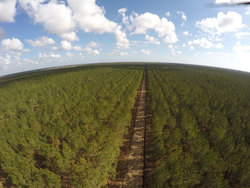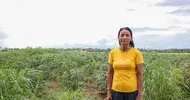
Bank of America’s Specialty Asset Management group manages more than 94,000 assets with a value of $13.6 billion for individuals and institutions looking for timberland, farms, ranches, energy interests, or real estate.
Wealthy families are adding forests to their portfolios
By Lananh Nguyen
Tom Crowder spent much of his two-year career in the NFL running away from men who weighed upwards of 300 pounds. These days? He worries about bears and snakes. As a senior vice president at Bank of America Corp., Crowder spends most days in the woods, from the evergreen forests of New England to the wetlands of the Carolinas, scouting U.S. timberland assets for people with a net worth of at least $100 million and a minimum of $10 million to invest.
“Trees don’t move as fast as Pro Bowl linebackers,” Crowder says on a recent field trip to a client’s timber farm in South Carolina overlooking the alligator-populated Waccamaw River. As turtles sun themselves and wild turkeys roam, he recounts over a picnic lunch the “neat experience” of his stint as a wide receiver and safety for the Dallas Cowboys. After a busted jaw and emergency surgery, he was happy to go back to his roots, as a third-generation forester.
Crowder is among more than 200 experts employed by Bank of America’s Specialty Asset Management group, or SAM, which manages more than 94,000 assets with a value of $13.6 billion for individuals and institutions. The target client is looking for timberland, farms, ranches, energy interests, or real estate, so-called alternative investments that can diversify portfolios mostly made up of stocks and bonds and can provide a hedge against inflation.
Returns for timberland totaled 3.2% in 2018, compared with 2.4% so far this year, according to an index from the National Council of Real Estate Investment Fiduciaries.
John Kelley, a SAM national executive, says “long-term themes” sell. The decline in arable land and rising global food demand, for example, are reasons to invest in farmland. “People have to eat, and what we believe about the intrinsic nature of these assets is that they have real value and they will persist over time,” he says.
For clients willing to make these long-term bets, SAM brings in what it calls boots-on-the-ground specialists from 38 offices across the U.S. They have an average of more than 15 years of experience, Kelley says, and some have been in their field for more than 30 years. Many, like Crowder, come from families who’ve been in those businesses for generations.
An exception is Nancy Fahmy, the head of alternative investments who was tapped to also lead SAM last year after spending most of her 23-year career dealing in esoteric financial assets in New York. “This is a different world for me,” she says, recalling the novelty of climbing onto a tractor for the first time and being intrigued by meeting a colleague wearing an impeccably tailored suit and alligator-skin cowboy boots, the product of a family hunt.
For Crowder, who grew up in Arkansas on his family’s timber farm, it’s familiar territory. While on the trip to the client’s timber tracts, a half-hour drive from Myrtle Beach in South Carolina, he used GPS maps on an extra-large iPad to show off an aerial view of pine trees annotated by the date they were planted. Then he offered instructions on how to use a T-shaped forestry tool, called an increment borer, to extract a section of wood about the size of a drinking straw from a tree to count its rings and gauge its pace of growth.
“People have to eat, and what we believe about the intrinsic nature of these assets is that they have real value and they will persist over time”
Crowder covered a lot of ground over the course of a day, giving a crash course in timber management. He detailed the widespread problem of wild hogs damaging timber properties. He talked about the benefits of recreational hunting clubs, which can offer a revenue stream for owners. He laughed about a catchphrase among colleagues—“release the deer”—a reference to the Chevy Chase movie Funny Farm. That’s what SAM staff say when an impressive animal is spotted on a site visit, as if they’d arranged it specifically to impress prospective buyers.
The bank’s roster of clients includes people from both the U.S. and overseas. Investors new to the arena are strongly encouraged to visit what they might be buying into, and it’s during these trips that the idea of passing on a legacy to future generations hits home, Kelley says. Wealthy families are also becoming more interested in environmental and sustainable investments, he says.
“It has a transformative effect in a lot of ways when they actually get to see it, feel it, touch it, and—sometimes in the case of farmland—smell it,” Kelley says. “It goes beyond the numbers.”
And the numbers for real-asset deals, such as predicted profits and hurdle rates, don’t correspond to typical Wall Street metrics. In some cases, the bank has to explain to sophisticated investors that the investments might not work for them.
The assets do produce revenue—in the form of logs, crops, livestock, or oil and gas—but buyers have to get comfortable with multiyear time horizons for returns. A timber farm could generate immediate sales or take years to harvest, depending on tree maturity and market conditions, or decades if starting from seed.
“This is not like stocks and bonds,” Kelley says. “This is not something that you buy on Monday and sell on Wednesday. That’s not the deal. If you’re not coming in with at least a minimum of a 10-year investment horizon, you really don’t belong in this investment class.”
There are other reasons to be careful. Universities including Yale and Harvard ran into trouble with their forestry investments in recent years after endowment funds bought into huge tracts of land as a way to hedge against inflation. The bets paid off handsomely until 2017, when returns slumped and the universities came under criticism from local residents and environmentalists. The various complaints included concerns about overlogging, destruction of scenery, and the disruption of animal habitats.
The California Public Employees’ Retirement System, the largest U.S. public pension system, is restructuring its forestland portfolio after its investments lost an average of 1.1% annually over the last 10 years, according to a presentation at a September meeting. The forestlands program has been under review the past few years and will likely be part of a broader examination by Ben Meng, who started in January as chief investment officer, CalPERS spokesman Joe DeAnda says.
That’s why Bank of America emphasizes the importance of its experts, who handpick properties for direct purchases. Farmland specialist Katie VanMeter comes from a family who owns thousands of acres of wheat and chickpeas in Montana. Shelda Owens, who runs operations for the timber business, has a master of science in forest economics. It might be argued that Crowder’s forestry experience goes as far back as his childhood. He cultivated his own sandbox-size plot of trees when he was a kid and had to make “hard decisions” about which ones to thin so the others could grow.
That depth of knowledge is important when the SAM experts are sitting across a table from savvy investors and being grilled by them—and, of course, when they’re showing off the land.
This story appears in the Family Office special report from Bloomberg Markets.Cover art: Rebecca Mock for Bloomberg Markets
Crowder goes to great lengths out there. He once waded through a waist-deep river, holding the iPad overhead, to assess a property that housed a cave of endangered bats. It wasn’t a good fit, and the bank decided not to manage the property. He prepares for site visits in great detail, readying contingency plans for weather-related disruptions. And he’s learning Mandarin to speak to Chinese clients, but it’s hard going: The Rosetta Stone program doesn’t always understand his Arkansas accent.
Among his clients are New Yorkers who consider Central Park a forest. He points out differences—on timber farms, there are no sidewalks, no lights, and sometimes no cellphone coverage. That off-the-grid experience and the opportunity to learn about nature are refreshing for visitors who might be titans of industry. Crowder enjoys being their guide.
“It’s incredible to make a career out of something that you’re so passionate about,” Crowder says. He spends much of his free time hiking in the forest next to his home in Little Rock, accompanied by his 100-pound giant schnauzer, Ranger. “That’s his passion, too.”












